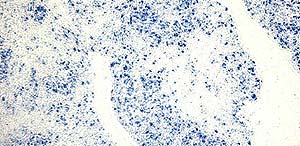Do we know how to detect new diseases? How long do we take to know exactly what we are dealing with regarding a new disease? The answers to these questions are not easy. The classical swine fever epidemic of 1997 was a “new” disease in the eyes of many veterinarians; the lack of practical experience means that a new appearance, although it may be from a well known base, can take a significant time to be diagnosed. If this happens with well characterized diseases it will be much worse with unknown diseases.
That was the case with what we now know as postweaning multisystemic wasting syndrome, (PMWS) and porcine circovirus diseases (PCVD) mainly used in Europe or porcine circovirus associated disease (PCVAD) which appeared more recently and is the name commonly used in North America. In 1991, veterinarian Dr. John Harding, from Western Canada, sent a group of transported pigs with noticeable wasting (figure 1) to undergo necropsy by a pathologist at the University of Saskatchewan (Canada), Dr. Edward Clark. The pathologic study revealed some microscopic lesions in the lymphoid system, of unknown origin, which were systematically present in the clinically affected animals. As there were no other affected farms the case was left until the disease reappeared in 1994. Dr. Harding was convinced that these cases were caused by the porcine reproductive and respiratory syndrome virus (PRRSV), but all the analysis of this virus were negative. In 1996, guided by the similarities of the lymphoid lesions with some produced by avian circovirus in the bursa of Fabricius, they sent samples to a scientist in Northern Ireland (Dr. Gordon Allan) who had carried out investigations on a apathogenic virus which was a contaminator of PK-15 cells and was known as porcine circovirus (PCV). All the affected pigs presented an enormous quantity of antigen against PCV (figure 2).
 |
 |
| Figure 1. Pig clinically affected with PMWS. Note the marked dorsal spine as well as the long and hirsute hair, characteristics found in a situation of wasting, but these characteristics do not clinically establish the diagnosis of a case of PMWS. | |
 |
|
| Figure 2. Very elevated presence of nucleic acid of type 2 porcine circovirus in inflammatory mononuclear cells (those which have a bluish colour). Technique of hybridization in situ. | |

At the same time a marked controversy began associated with this disease which has lasted for practically ten years. An apathogenic virus which reverts back to being virulent? Could it be that the cause is another and that this virus is “simply” there? In 1998, through studies on nucleotidic sequence, it was shown that the PCV associated to the cases of PMWS were distinct from the cellular contaminating PCV, and these agents were classified as PCV type 2 (PCV2) and type 1 (PCV1), respectively. Nevertheless, epidemiologic studies demonstrated that PCV2 is ubiquitous and is present both in farms with and without circovirus disease. More controversy!!
Despite the fact that scientists that work with PCV2 have been offering evidence of the implication of this virus in the disease, the lack of a consistent model of experimental reproduction and the ubiquity of the agent give rise to serious doubts as to the importance of PCV2 as a causal agent. Important members of the scientific community and leaders of opinion in veterinary practice sustain that PCV2 was a simple agent of the disease and that another agent existed that had to be the trigger, and therefore the main agent, of this syndrome. More than ten years on, and this presumed “agent X” has still not been found. So, does it exist? Well, we don’t know… if it does exist we haven’t been able to find it yet! But time has passed, and as could be expected, vaccination products have been developed against PCV2. It was a major surprise when the first results of these vaccination products in Europe, and especially in North America (epizootic context of the disease since 2004-05), showed a very significant reduction in mortality and in the number of slow growth pigs, regardless even of the vaccination product used (there are currently four commercial vaccines for PCV2 on the world market, three for vaccinating piglets and one for the vaccination of sows).
These results caused in stir in the veterinary world since few expected such an evident and consistent effect of vaccination. Moreover, for a disease where there was once a clear bipolarity (“circo-believers versus circo-sceptics”), there is now no doubt about the fundamental and necessary role of PCV2 in its development. However, this situation does not clear up the doubts about the existence or not of a potential “agent X”!
The idea of this series of articles on PCV2 and porcine circovirus diseases is to present the newest aspects, especially from the practical point of view, on the etiology, pathogeny, epidemiology, diagnosis, treatment and prevention of the disease. A possible hypothesis will also be presented on the emergence of porcine circovirus at a worldwide level.


